|
Vesuvius is famous for the catastrophic eruption in 79 A.D. that buried
the towns of Herculaneum and Pompeii.
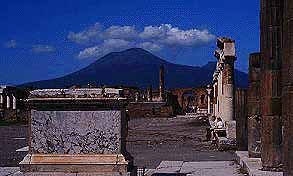 The 79 A.D. eruption of Vesuvius was the first volcanic eruption ever to
be described in detail. From 18 miles (30 km) west of the volcano, Pliny
the Younger, witnessed the eruption and later recorded his observations
in two letters. He described the earthquakes before the eruption, the
eruption column, air fall, the effects of the eruption on people,
pyroclastic flows, and even tsunami. Volcanologists now use the term
"plinian" to refer to sustained explosive eruptions which generate
high-altitude eruption columns and blanket large areas with ash. It is
estimated that at times during the eruption the column of ash was 20
miles (32 km) tall. About 1 cubic mile (4 cubic kilometers) of ash was
erupted in about 19 hours.
The 79 A.D. eruption of Vesuvius was the first volcanic eruption ever to
be described in detail. From 18 miles (30 km) west of the volcano, Pliny
the Younger, witnessed the eruption and later recorded his observations
in two letters. He described the earthquakes before the eruption, the
eruption column, air fall, the effects of the eruption on people,
pyroclastic flows, and even tsunami. Volcanologists now use the term
"plinian" to refer to sustained explosive eruptions which generate
high-altitude eruption columns and blanket large areas with ash. It is
estimated that at times during the eruption the column of ash was 20
miles (32 km) tall. About 1 cubic mile (4 cubic kilometers) of ash was
erupted in about 19 hours.
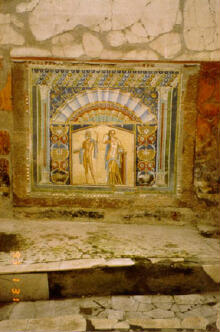
About 10 feet (3 m) of tephra, sooty ash fell on Pompeii, burying
everything except the roofs of some buildings. The city was abandoned
and its location forgotten.
In 1595, excavations discovered artifacts at
Pompeii and centuries of pillaging followed. Archeological excavations
began in the mid-nineteenth century. Now, much of Pompeii has been
excavated and it has revealed much about how people lived during that
time (and died during the eruption).
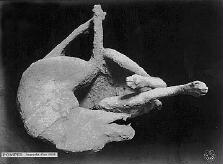 There are numerous molds of people
in their final moments. The mold of a dog is shown in the photo.
The poor animal was chained to a post and struggled for hours before
finally succumbing to the ash.
There are numerous molds of people
in their final moments. The mold of a dog is shown in the photo.
The poor animal was chained to a post and struggled for hours before
finally succumbing to the ash.
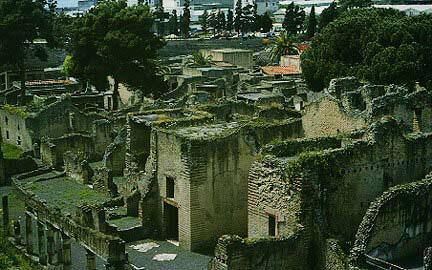 Herculaneum was buried under 75 feet (23 m) of ash deposited by a
pyroclastic flow. Herculaneum was buried under 75 feet (23 m) of ash deposited by a
pyroclastic flow.
Herculaneum, once a seaside resort, is now surrounded by the modern city
of Ercolano. About 5,000 people lived in the city at the time of the
eruption.
Vesuvius has erupted about three dozen times since 79 A.D., most recently
from 1913-1944. The 1913-1944 eruption is thought to be the end of an
eruptive cycle that began in 1631. 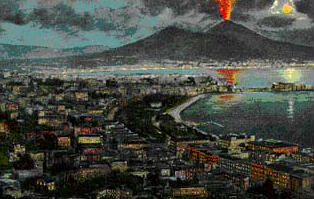 Vesuvius is a dangerous and deadly volcano. Mudflows and lava flows from the eruption in 1631 killed 3,500 people. About 3,360 people died in the 79 A.D. eruption from ash flows and falls. Studies of past eruptions and their
deposits continue. These studies help volcanologists understand the
hazards associated with future eruptions.
Vesuvius is a dangerous and deadly volcano. Mudflows and lava flows from the eruption in 1631 killed 3,500 people. About 3,360 people died in the 79 A.D. eruption from ash flows and falls. Studies of past eruptions and their
deposits continue. These studies help volcanologists understand the
hazards associated with future eruptions. 
The population density in
some areas of high risk is 20,000 to 30,000 per square km.
About 3
million people could be seriously affected by future eruptions. In the
first 15 minutes of a medium- to large-scale eruption an area with a 4
mile (7 km) radius of the volcano could be destroyed (Dobran and others,
1994). About 1 million people live and work in this area.
 Return to the Fridge door Return to the Fridge door
| 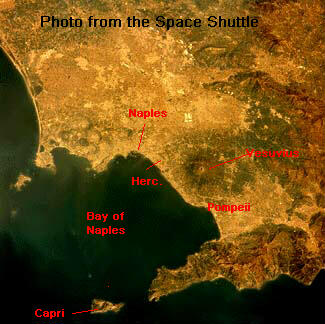
 Vesuvius, Italy
Vesuvius, Italy

 Return to the Fridge door
Return to the Fridge door